基因突变、多态性及疾病基因的定位和鉴定
人类基因组中的多态性分析与医学应用
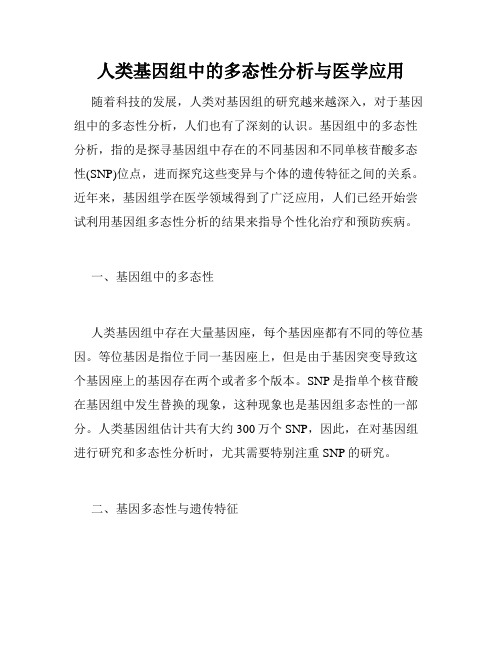
人类基因组中的多态性分析与医学应用随着科技的发展,人类对基因组的研究越来越深入,对于基因组中的多态性分析,人们也有了深刻的认识。
基因组中的多态性分析,指的是探寻基因组中存在的不同基因和不同单核苷酸多态性(SNP)位点,进而探究这些变异与个体的遗传特征之间的关系。
近年来,基因组学在医学领域得到了广泛应用,人们已经开始尝试利用基因组多态性分析的结果来指导个性化治疗和预防疾病。
一、基因组中的多态性人类基因组中存在大量基因座,每个基因座都有不同的等位基因。
等位基因是指位于同一基因座上,但是由于基因突变导致这个基因座上的基因存在两个或者多个版本。
SNP是指单个核苷酸在基因组中发生替换的现象,这种现象也是基因组多态性的一部分。
人类基因组估计共有大约300万个SNP,因此,在对基因组进行研究和多态性分析时,尤其需要特别注重SNP的研究。
二、基因多态性与遗传特征基因多态性与遗传特征之间的关系非常密切。
在基因多态性的研究过程中,研究人员首先寻找 SNP 以及等位基因的分布情况,然后他们会调查这些不同等位基因是否存在不同的表型中的分布情况。
这个过程就是寻找等位基因与个体遗传表现之间的关系。
这种关系被称为联系-非连锁不平衡(LD),是基因多态性分析的基础。
例如,在基因的编码区发生了突变,可能会导致这个基因的编码序列被改变,或者从而改变这个基因的功能,这些改变可能会对表型表现产生影响。
对于某些SNP来说,它们的基因型决定了某些表型特征的发生概率,例如毛色、眼睛颜色、身高。
同时,基因多态性的研究没有终止,也存在不少的困难,比如SNP在种族间普遍存在,而其表现遗传特征不易准确找到。
三、用于医学中的基因多态性分析众所周知,基因是影响所有生命活动的重要成分,各种疾病也可以追溯至基因的表现。
某些基因具备促进疾病的表现,例如诱发某些肿瘤的基因、早期心血管疾病、糖尿病等等。
但是,基因不是唯一的诱因。
环境和行为等不同因素也可能影响个体是否发生疾病,所以评估单个基因的重要性仍是很有限的。
遗传学和基因组学中的变异和多态性
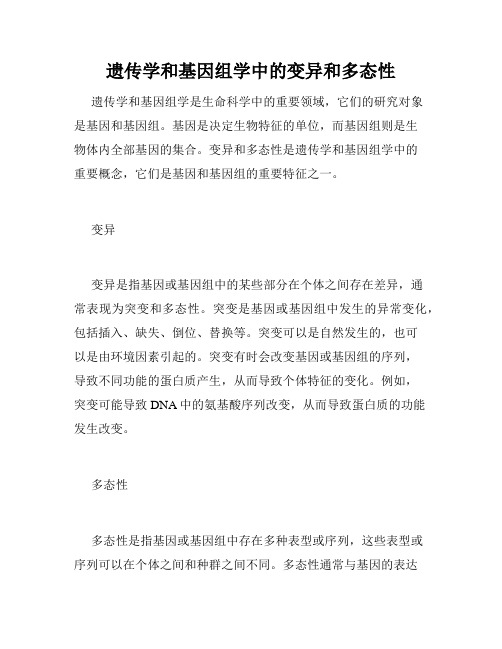
遗传学和基因组学中的变异和多态性遗传学和基因组学是生命科学中的重要领域,它们的研究对象是基因和基因组。
基因是决定生物特征的单位,而基因组则是生物体内全部基因的集合。
变异和多态性是遗传学和基因组学中的重要概念,它们是基因和基因组的重要特征之一。
变异变异是指基因或基因组中的某些部分在个体之间存在差异,通常表现为突变和多态性。
突变是基因或基因组中发生的异常变化,包括插入、缺失、倒位、替换等。
突变可以是自然发生的,也可以是由环境因素引起的。
突变有时会改变基因或基因组的序列,导致不同功能的蛋白质产生,从而导致个体特征的变化。
例如,突变可能导致DNA中的氨基酸序列改变,从而导致蛋白质的功能发生改变。
多态性多态性是指基因或基因组中存在多种表型或序列,这些表型或序列可以在个体之间和种群之间不同。
多态性通常与基因的表达和功能有关,它是适应环境变化的一种策略。
多态性可以是单核苷酸多态性,即SNP,可以是微卫星多态性,即STR。
SNP是指单个核苷酸的变异,通常在整个基因组中广泛分布。
STR是指短重复序列的变异,通常位于基因组中的非编码区域。
多态性对生物研究的影响多态性在生物研究中具有广泛的应用。
例如:1.基因组学的进展:基因组学研究基因和基因组的结构和功能。
多态性可以帮助识别疾病相关基因,并加深对基因功能的了解。
例如,SNP可以用于进行基因关联研究,帮助识别疾病相关基因。
2.种群遗传学的研究:种群遗传学研究人类种群之间的遗传变异,以及这些变异与人类演化和疾病之间的关系。
多态性是种群遗传学研究中的重要标志,可以用于研究人类群体的起源和迁徙,以及疾病发生和治疗策略的研究。
3.个体化医疗的进展:个体化医疗是利用遗传信息和个体疾病信息,根据个体的基因组特征制定个性化的治疗方案。
多态性是个体化医疗研究中的重要因素,可以帮助识别疾病相关基因并确定特定药物治疗策略。
结论变异和多态性是遗传学和基因组学中重要的概念,它们是基因和基因组的特征之一。
人类基因多态性和疾病的关系

人类基因多态性和疾病的关系人类基因多态性是指在人类群体中存在着多种基因型的现象。
一个基因座上的某些位点上的等位基因的频率不同而表现出来的现象称为基因多态性。
这种现象也是人类种群多样性的原因之一。
基因多态性是人类群体的一种普遍现象,它与人类疾病的发生和发展密切相关。
就目前医学领域的研究而言,基因多态性在很大程度上决定了人类疾病的易感性、病程、病情及预后等方面。
接下来,从基因多态性、疾病易感性、基因治疗等方面进行讨论。
基因多态性人类基因是由许多不同基因状体(等位基因)组成,每个等位基因编码着一个特定的蛋白质,控制着人类各种生理和代谢过程。
在人类种群中不同等位基因频率的存在是基因多态性的基础。
在人体中,许多疾病的发生和发展与基因多态性密切相关。
例如,疟疾的发生与基因座在细胞膜基质中所表达的血型抗原有关;糖尿病的易感性与HLA-DQ等位基因有关;胆固醇代谢的异常与APOE基因等位基因有关。
疾病易感性基因多态性在疾病的易感性中起到了至关重要的作用。
每个人在受到外界环境的影响下,可能会发展出不同的健康结果。
但是当人们具有某些特定等位基因时,他们更容易发展成为某种特定的健康结果,从而产生与其他人不同的健康风险。
例如,BRCA1和BRCA2等位基因是乳腺癌的高风险基因。
具有这些突变等位基因的女性比普通人患乳腺癌的风险要高得多。
类似地,个体环境中的某些因素(如烟草、某些药物等)可以增加未来肺癌的风险,但如果一个个体有这种情况的特定等位基因,那么他的风险就比其他人更高。
基因治疗随着基因研究的发展,基因治疗已成为目前医学研究中一个重要的方向。
基因治疗可以通过调整或改变特定基因在患者体内表达的方式,从而达到治疗疾病的目的。
比如说,固缩斑症(PKU)是一种由于身体缺乏酪氨酸羟化酶而引起的遗传疾病,患者可能会造成智力和神经系统损害。
目前,科学家们已经开发出了一种方法来治疗PKU,该方法利用了基因治疗的原理。
他们将正常基因序列注入血管中,以便它能够进入肝细胞并在患者体内表达正常的酪氨酸羟化酶,以代替缺少的酶,从而缓解患者的症状。
人类基因多态性与疾病的关系分析

人类基因多态性与疾病的关系分析人类基因组中存在着极为丰富的多态性,即人们常说的“基因变异”。
这种多态性不仅决定了人类的生理和形态上的差异,也与许多疾病密切相关。
这篇文章将分析人类基因多态性与疾病之间的关系,探究基因多态性在疾病发生发展中的重要角色。
一、基因多态性是什么?基因是人类遗传信息的单位,由DNA分子组成。
在整个人体细胞的基因组中,基因的数量大约是2.5万个。
基因多态性指的是人类基因组中同一基因序列的不同变异形式,其中常见的包括单核苷酸多态性(SNP)和插入/缺失多态性(Indel)等。
这些基因多态性可能直接影响蛋白质的结构和功能,进而影响个体在生理、病理等方面的表现。
二、基因多态性与疾病之间的关系基因多态性与疾病之间的关系极为复杂,既包括遗传性疾病,也包括由环境因素和基因相互作用引起的复杂疾病。
遗传性疾病由于起源于基因的突变或缺失,因此患病风险的遗传方式通常是简单的单基因遗传。
常见的遗传性疾病包括囊性纤维化、苯丙酮尿症和地中海贫血等,这些疾病与特定基因的突变密切相关。
例如,囊性纤维化是由CFTR基因的突变引起的,苯丙酮尿症则源于PAH基因的突变。
复杂疾病则更为常见,这些疾病如高血压、糖尿病、哮喘、癌症等,由环境、遗传和相互作用等多种因素共同作用而引起。
在复杂疾病中,基因多态性对个体患病风险的影响往往是渐进性的并且是相对的。
例如,在冠心病的发病中,APOE基因多态性的影响随着年龄增长而增加。
三、基因多态性的研究方法目前,研究基因多态性与疾病之间的关系主要采用全基因组关联研究(GWAS)和功能基因组学两种方法。
GWAS是通过大样本研究,对表型、基因型和环境因素进行分析,从而找到与疾病相关的SNP。
功能基因组学则是研究基因与基因之间的相互作用关系,可以深入剖析基因在疾病发生发展中的详细机制。
这两种方法的结合可以大大提高研究效率和科技准确性。
四、基因多态性研究的局限性研究基因多态性与疾病之间的关系还面临着一些困难和限制。
基因突变和多态性

基因突变和多态性基因突变和多态性是遗传学中的重要概念,它们在生物进化和个体间的变异中起着关键作用。
本文将探讨基因突变和多态性的定义及其在生物界的意义,以及它们对生物适应性和人类健康的影响。
一、基因突变的定义与分类基因突变是指DNA序列发生的一种突然而异常的变化,它是遗传信息的重要组成部分。
基因突变可以分为多种类型,包括点突变、插入突变、缺失突变和倒位突变等。
这些突变可能会影响基因的表达和功能,进而导致生物性状发生变化。
二、基因突变对生物进化的重要性基因突变是生物进化的基础,它为生物体的遗传多样性提供了源源不断的新变异。
基因突变可以使得个体具备适应环境的新特征,从而在竞争中获得优势并传递给后代。
这种累积的遗传变异是进化的主要驱动力之一。
三、多态性的定义与种类多态性是指在一个种群中存在多种形态或表型的现象。
基因多态性是多态性的一个重要表现形式,它指的是同一基因具有多种等位基因,并且不同等位基因可能对生物表型产生不同的影响。
多态性可以分为基因型多态性和表型多态性。
四、多态性对生物适应性的影响多态性可以增强群体的适应性和生存能力。
一方面,基因多态性使得生物个体对变化环境具备更多的适应选择余地,可以减轻环境压力对群体的冲击。
另一方面,多态性还可以促进生物的繁殖和繁殖成功率,提高遗传多样性。
五、基因突变和多态性在人类健康中的作用基因突变和多态性在人类健康中扮演重要角色。
一些基因突变可能导致人类遗传病的出现,如囊性纤维化、镰刀细胞性贫血等。
然而,基因多态性也可以带来一定的优势,如免疫系统的多态性有助于人类抵抗疾病。
了解基因突变和多态性对人类健康的影响,对疾病的预防和治疗具有重要意义。
六、探索基因突变和多态性的未来研究方向随着科学技术的进步,我们对基因突变和多态性的认识还在不断深化。
未来的研究方向包括基因突变的机制解析、多态性与环境交互作用的探索,以及利用基因突变和多态性的知识开展针对遗传病的治疗和预防等。
总结:基因突变和多态性对生物界的影响是不可忽视的。
人体基因组的多态性与遗传疾病
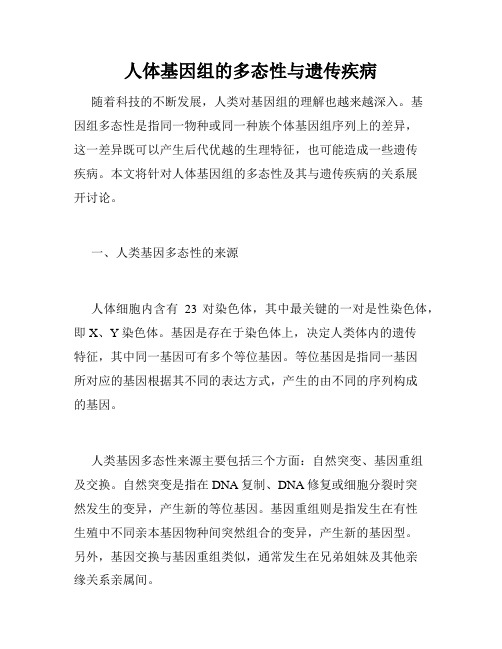
人体基因组的多态性与遗传疾病随着科技的不断发展,人类对基因组的理解也越来越深入。
基因组多态性是指同一物种或同一种族个体基因组序列上的差异,这一差异既可以产生后代优越的生理特征,也可能造成一些遗传疾病。
本文将针对人体基因组的多态性及其与遗传疾病的关系展开讨论。
一、人类基因多态性的来源人体细胞内含有23对染色体,其中最关键的一对是性染色体,即X、Y染色体。
基因是存在于染色体上,决定人类体内的遗传特征,其中同一基因可有多个等位基因。
等位基因是指同一基因所对应的基因根据其不同的表达方式,产生的由不同的序列构成的基因。
人类基因多态性来源主要包括三个方面:自然突变、基因重组及交换。
自然突变是指在DNA复制、DNA修复或细胞分裂时突然发生的变异,产生新的等位基因。
基因重组则是指发生在有性生殖中不同亲本基因物种间突然组合的变异,产生新的基因型。
另外,基因交换与基因重组类似,通常发生在兄弟姐妹及其他亲缘关系亲属间。
二、基因多态性与遗传疾病基因多态性和遗传疾病之间存在一定的相关性。
一般来说,基因多态性对于单基因遗传病的发病率没有太大影响。
但对于一些复杂性疾病,基因多态性是决定疾病形成的重要因素之一。
1.单基因遗传病单基因遗传病大多数情况下仅因单一基因的突变所引起,主要分为显性遗传和隐性遗传两种类型。
其中以囊性纤维化为例,这种病是由某一单基因的突变质变所引起的,危害程度相对较高。
相反,血红蛋白C病的影响程度相对较轻,虽然也是遗传型隐性但发病率较低。
2.复杂遗传病复杂遗传疾病是指由多个基因突变、外部环境及其他因素共同引起的疾病,如高血压、糖尿病等。
通常,这些疾病的发病率由基因环境因素所主导,并不受单一基因的调节。
三、某些基因的多态性与疾病的联系人类基因组多态性非常复杂,现代医学已经证明很多基因与疾病之间存在着一定的联系。
在这方面进行了深入的研究,以下是几个案例:1. ACE基因多态性与高血压ACE(血管紧张素转换酶)基因多态性和高血压之间存在一定的相关性。
基因突变检测内容
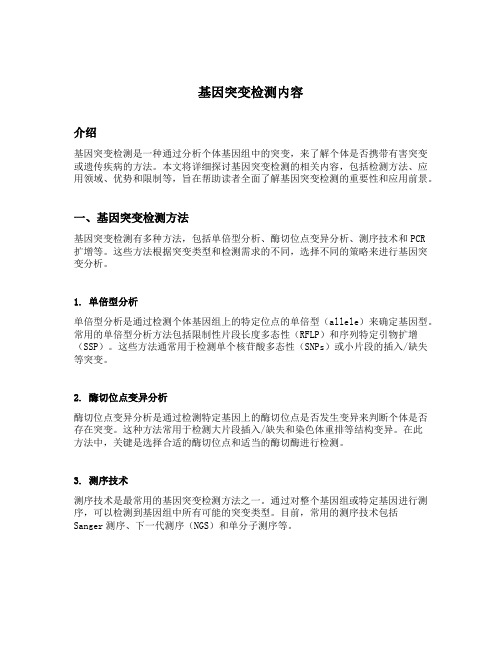
基因突变检测内容介绍基因突变检测是一种通过分析个体基因组中的突变,来了解个体是否携带有害突变或遗传疾病的方法。
本文将详细探讨基因突变检测的相关内容,包括检测方法、应用领域、优势和限制等,旨在帮助读者全面了解基因突变检测的重要性和应用前景。
一、基因突变检测方法基因突变检测有多种方法,包括单倍型分析、酶切位点变异分析、测序技术和PCR扩增等。
这些方法根据突变类型和检测需求的不同,选择不同的策略来进行基因突变分析。
1. 单倍型分析单倍型分析是通过检测个体基因组上的特定位点的单倍型(allele)来确定基因型。
常用的单倍型分析方法包括限制性片段长度多态性(RFLP)和序列特定引物扩增(SSP)。
这些方法通常用于检测单个核苷酸多态性(SNPs)或小片段的插入/缺失等突变。
2. 酶切位点变异分析酶切位点变异分析是通过检测特定基因上的酶切位点是否发生变异来判断个体是否存在突变。
这种方法常用于检测大片段插入/缺失和染色体重排等结构变异。
在此方法中,关键是选择合适的酶切位点和适当的酶切酶进行检测。
3. 测序技术测序技术是最常用的基因突变检测方法之一。
通过对整个基因组或特定基因进行测序,可以检测到基因组中所有可能的突变类型。
目前,常用的测序技术包括Sanger测序、下一代测序(NGS)和单分子测序等。
4. PCR扩增PCR扩增是一种常用的突变检测方法,通过特定序列的扩增来检测基因组中的突变。
PCR扩增可以用于检测单个核苷酸多态性、小片段插入/缺失以及基因的重复序列等突变。
此外,PCR扩增也可用于基因组的特定区域富集,以便后续测序分析。
二、基因突变检测的应用领域基因突变检测在医学、生物学和遗传学等领域有着广泛的应用。
下面将分别探讨其在这些领域中的具体应用。
1. 医学应用基因突变检测在医学中的应用非常广泛。
它可以用于遗传性疾病的诊断和预测。
通过检测个体基因组中与特定疾病相关的突变,可以及早发现患者的病情并制定相应的治疗方案。
基因定位方法及应用技术

基因定位方法及应用技术基因定位方法及应用技术是现代生物学和医学领域的重要研究内容,它可以帮助科学家们确定基因在染色体上的具体位置,从而对生物体的遗传特性和相关疾病进行深入研究。
下面将从基因定位方法的原理和常用技术入手,详细介绍基因定位方法及应用技术的相关内容。
一、基因定位方法的原理基因定位是指确定基因位点在染色体上的具体位置。
由于染色体是细胞核内遗传物质的主要载体,因此,在基因定位方法中,科学家一般通过确定基因在染色体上的位置来确定基因的存在和活动。
基因定位方法的原理主要包括以下几个方面:1. 同源重组原理:同源重组是指染色体上的两个相同或相似的基因在染色体交换的过程中发生重组,从而导致两个基因的位置发生改变。
通过分析这种重组现象,科学家可以确定两个基因在染色体上的相对位置。
2. 遗传分析原理:遗传分析是一种通过研究基因在不同个体中的分布规律来确定基因位置的方法。
它可以通过观察某一基因的基因型和表型在不同群体中的分布,结合遗传距离和交联图谱等参数,推断基因在染色体上的位置。
3. 分子标记原理:分子标记是一种通过使用特定的分子标记物来确定基因在染色体上的位置的方法。
常用的分子标记物包括限制性片段长度多态性(Restriction Fragment Length Polymorphism,RFLP)、单核苷酸多态性(Single Nucleotide Polymorphism,SNP)和微卫星等。
通过分析分子标记物在染色体上的分布规律,科学家可以确定基因的位置。
二、常用的基因定位方法及应用技术1. 位点克隆法(Site Cloning):位点克隆法是通过将某个感兴趣的基因序列与染色体上的特定位点发生连接,然后将连接后的染色体片段插入到表达载体中进行研究。
该方法可以用来检测基因的表达情况、调控机制以及与其他基因的相互作用等。
2. 靶向敲除法(Targeted Knockout):靶向敲除法是一种通过人为干预基因活动来研究基因功能的方法。
人类基因多态性及其在疾病发生中的作用

人类基因多态性及其在疾病发生中的作用人类基因多态性(Genetic Polymorphism)是指人类种群中存在的基因序列变异,它是人类遗传多样性的重要体现。
每个人的基因都有差异,而这种差异不仅体现在不同个体间,也存在于同一个个体的不同细胞之间,这就是人类基因多态性。
基因多态性的存在可以导致人类群体的非同质性,它对人类疾病发生和药物反应等方面都起到了极其重要的作用。
基因多态性对疾病发生的影响主要表现在以下几个方面:基因多态性与遗传性疾病的关系许多常见的遗传性疾病比如先天愚型、遗传性肿瘤等都是由于某些基因异常而导致的。
这些基因的异常可以是包括点突变、基因扩增、基因缺失等形式。
例如BRCA1和BRCA2基因的突变会增加患乳腺癌和卵巢癌的风险。
因此,基因多态性的存在可以对个体患上遗传性疾病的风险产生重要影响。
如果基因多态性中存在可导致疾病发生的基因突变,那么患病风险会大大增加。
基因多态性与环境因素的互动环境因素可以直接或间接地与遗传因素互动,这种互动可以影响个体遗传物质的表达方式。
环境的作用可以通过影响基因的在特定组织和特定时间点的表达,从而导致某些疾病的发生。
例如,婴儿出生时就受到环境因素的影响,如母亲的吸烟等。
这些环境因素可能会改变基因的表达方式,从而导致基因发生突变,增加患病风险。
基因多态性对药物反应的影响不同的人在同一治疗下的药物反应也可能会有所不同。
这是因为基因多态性导致了不同个体药代动力学和药效学差异。
药物的代谢与解毒主要发生在肝脏酶的作用下,改变酶的活性、含量或产物的稳定性等都可能会影响对药物的代谢,从而影响药效。
例如,靶向抗癌药物西妥昔单抗没有效果的患者,通常是因为基因多态性的存在,导致抗体无法结合瘤细胞发挥作用。
因此,对基因多态性的了解可以为个体制定个性化治疗提供重要依据。
总之,基因多态性在人类的疾病发生和药物反应等方面发挥了非常重要的作用。
未来,进一步研究基因多态性的变异和它对人类健康的影响,将为个性化治疗和疾病预防提供更具体和更灵活的依据。
突变和多态的分析

部分。
03
蛋白质多态性
指蛋白质分子中氨基酸的排列顺序发生改变,包括氨基酸的替换、缺失
和插入等。
多态的分子中发生碱基对的替换、增添和缺失,而引起的基因结
构的改变。
基因重组
02
生物体进行有性生殖的过程中,控制不同性状的基因重新组合。
环境因素
03
如温度、湿度、光照、土壤等环境因素的变化,可以影响生物
毛细管电泳
利用毛细管电泳技术分离DNA 片段,然后通过荧光检测器检
测突变位点和类型。
03
多态的分析
多态的类型
01
基因多态性
指在一个生物群体中,同时和经常存在两种或多种不连续的变异型或基
因型(等位基因)或表型(表现型),亦称遗传多态性或基因多态性。
02
表型多态性
指生物个体在表型水平上所展示的多态性,它是生物多样性的重要组成
遗传突变
父母将突变基因传递给后代,导致后代发生突变。
突变的检测方法
Sanger测序
通过特定的引物对目标DNA片段 进行扩增,然后对扩增产物进行 测序,以确定突变位点和类型。
二代测序
利用高通量测序技术对大量 DNA片段进行同时测序,能够 快速、准确地检测突变。
单分子测序
直接对单个DNA分子进行测序 ,无需PCR扩增,能够检测极 低频率的突变。
推动生物信息学和计算生物学的发展
突变和多态研究将产生海量的基因组数据,需要借助生物信息学和计算生物学的方法和技术进行 高效、准确的分析和解读,推动相关学科的发展和创新。
THANKS
感谢观看
突变和多态的分 析
目录
• 引言 • 突变的分析 • 多态的分析 • 突变和多态在生物学中的意义 • 突变和多态的研究方法和技术 • 突变和多态的未来研究方向和挑
[医学]遗传多态性与基因突变
![[医学]遗传多态性与基因突变](https://img.taocdn.com/s3/m/9fcceb04d5bbfd0a795673d4.png)
物理因素
✓ 紫外线
紫外线的照射可使DNA顺序中相邻 的嘧啶类碱基结合成嘧啶二聚体,最常 见的为胸腺嘧啶二聚体(TT)。在复制 或转录进行时,该处碱基配对发生错误, 从而引起新合成的DNA或RNA链的碱基 改变。
紫 外 线 诱 发 的 胸 腺 嘧 啶 二 聚 体
物理因素
续
。
✓ 电离辐射
射线直接击中DNA链,DNA分子吸 收能量后引起DNA链和染色体的断裂, 片断发生重排,引起染色体结构畸变.
✓ VNTR 区域
VNTR 示意图
VNTR的特点 :
➢ 按孟德尔方式遗传 ➢ 复等位基因, 多态信息含量高 ➢ 用于个体鉴别、遗传分析和基因定位等
DNA指纹
用适当的限制性内切酶消化基因组DNA, 从各位点可获得一系列长度不等的小卫星片 断,如用适当的探针做印记杂交, 获得的具 有高度个体特异性的带谱。 用途:个体识别、亲子鉴定
✓ 环境因子易感基因的检出 ✓ 指导用药和药物设计
肝酯酶基因启动子区的一个多态与他汀类降血脂的效果 有高度的相关性
(Zambon A, et al Circulation, 2001, 103(6) :792-798)
参考文献
➢ 张思仲.人类基因组的单核苷酸多态性及其医学应用, 《中华医学遗传学杂志》1999,16(2):119-121.
➢ 张思仲. 基因多态性研究与遗传性疾病,《中华
医学遗传学杂志》2000,80(9):654-656.
基因突变的概念
基因突变(gene mutation)是 指基因组DNA分子某些碱基或其 顺序发身改变.
基因突变
生物进化的基础 产生新的基因 遗传病产生的原因
基因突变的分子机制
一般分为两大类-静态突变和动态 突变。
生物遗传中的基因突变与多态性

生物遗传中的基因突变与多态性生物体的遗传性状是由基因决定的,而基因又是由一条或多条DNA序列编码而来的。
基因的突变和多态性是生物演化和生物种群的形成过程中非常重要的遗传变异形式。
既有它们的利用价值,又有它们的适应性缺陷。
因此,了解基因突变和多态性的原理是生物遗传学研究中不可或缺的基础。
基因突变与多态性的定义基因突变是指对基因序列进行的一系列次生改变。
这些次生改变包括单个核苷酸的改变、插入或删除、重复或翻译错误的突变等等。
而基因多态性则是指同一个位置的基因序列,由于不同的个体间存在细小的序列差异而产生的遗传变异。
基因突变和多态性是生物体塑造形态和功能多样性的基础。
基因突变和多态性的原理基因突变和多态性的发生机制是非常复杂且多样的。
然而,大部分的基因突变和多态性可以概括为以下几类。
第一类是自然选择。
自然选择是一种自然界由于环境适应而产生的机制。
在生命演化的过程中,个体之间存在着不同的表现型,有些表现型比其他表现型更适应环境,自然选择可以使这些适应性表现型得以保存下来,而其他表现型则被淘汰或较少。
第二类是突变和多态性。
在基因复制和转录过程中,个体的基因序列会发生未知突变,在后代中产生多态性。
这种变异能够创造新的表现型,有些新表现型可能是更适应环境的,自然选择会保存下来,也可能有些新表现型是弱化的,这种情况更可能出现再生障碍、疾病和致命的后果。
第三类是基因拼合和扩增。
基因拼和基因扩增是两种重要的基因多态性产生机制,它们可以使新的基因序列产生局部性的增加或全基因库的扩增。
在基因拼合和扩增的过程中,新的基因序列会通过自然选择和随机漂移等机制产生变异,形成新的遗传多样性。
基因突变和多态性的应用价值基因突变和多态性在遗传学和进化生物学中有着重要的应用价值。
例如,基因突变和多态性可以被用来检测人类疾病和疾病的易感性,可以被用来确定个体和生物种群的亲缘关系,可以被用来研究生物进化和演化的过程。
基因突变和多态性还可以被用来研究生物个体和群体的分化和适应性。
医学遗传学基因突变与遗传多态性

基因突变是导致个体间遗传差异的主要原因之一,它可以引起DNA序列的变化, 从而影响个体的表型和特征。
基因突变与遗传多态性的区别
性质不同
基因突变具有不定向性,即可能产生有益、有害或中性的变 异,而遗传多态性是指不同个体间的基因序列差异,这种差 异通常是中性或有益的。
范围不同
在杂合子中,等位基因可以相互掩盖彼此的影响,表现出 一种中间表型。而在纯合子中,不同等位基因的组合会导 致不同的表型表现。
03
基因突变与遗传多态性的关系
基因突变与遗传多态性的联系
遗传多态性是基因突变的产物
遗传多态性是指个体间基因的微小差异,这种差异往往是由基因突变引起的,特 别是单核苷酸多态性(SNP)。
05
参考文献多态性的研究进展 作者:张三、李四、王五
THANKS
感谢观看
基因突变的类型
基因突变可以根据其发生的部位、方式、后果等进行 分类。根据发生的部位,基因突变可分为点突变、插 入突变、缺失突变等;根据发生的方式,可分为自发 突变和诱发突变;根据后果,可分为致死突变、半致 死突变和可存活突变等。
基因突变的诱因
基因突变的诱因可以分为内因和外因。内因包括DNA复制过 程中碱基配对的错误、DNA的损伤修复机制缺陷等;外因则 包括物理因素(如X射线、激光等)、化学因素(如亚硝酸 、碱基类似物等)、生物因素(如病毒、细菌等)等。
疾病控制
医学遗传学的研究可以帮助医生更好地理解某些疾病的遗传基础,从而为制定更 加精确的治疗方案提供依据,有助于控制疾病的传播和恶化。
医学遗传学的未来发展
新技术应用
随着新技术的不断发展,如单细胞测序、全基因组关联研究 等,医学遗传学将有更多的机会揭示基因突变与疾病之间的 复杂关系。
基因突变和基因多态性的关系
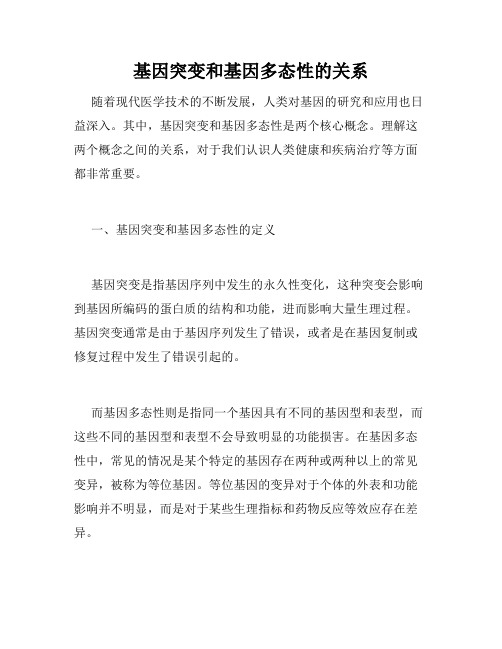
基因突变和基因多态性的关系随着现代医学技术的不断发展,人类对基因的研究和应用也日益深入。
其中,基因突变和基因多态性是两个核心概念。
理解这两个概念之间的关系,对于我们认识人类健康和疾病治疗等方面都非常重要。
一、基因突变和基因多态性的定义基因突变是指基因序列中发生的永久性变化,这种突变会影响到基因所编码的蛋白质的结构和功能,进而影响大量生理过程。
基因突变通常是由于基因序列发生了错误,或者是在基因复制或修复过程中发生了错误引起的。
而基因多态性则是指同一个基因具有不同的基因型和表型,而这些不同的基因型和表型不会导致明显的功能损害。
在基因多态性中,常见的情况是某个特定的基因存在两种或两种以上的常见变异,被称为等位基因。
等位基因的变异对于个体的外表和功能影响并不明显,而是对于某些生理指标和药物反应等效应存在差异。
二、基因突变和基因多态性本质上是两个不同的概念,但两者之间存在着密切的联系。
基因突变是基因多态性的一种重要形式,也是基因多态性形成的重要原因之一。
一方面,基因突变可以引起等位基因的产生,加速等位基因的演化和变异,从而扩大了基因多态性的范围。
在许多情况下,基因突变是基因多态性最直接的原因之一,如血型等位基因的演化就是由于基因突变所产生的。
另一方面,基因多态性可以在一定程度上抵消基因突变带来的损伤。
在等位基因众多的基因多态性的背景下,个体往往会拥有多样化的基因组,这种多样性能够帮助人体适应各种不同的环境和压力,增强人体的适应性和自我修复能力。
三、基因突变和基因多态性的应用理解基因突变和基因多态性的关系是非常重要的,因为这对于科学家们在基因研究和治疗方面的工作会产生很大的影响。
在基因研究方面,基因突变和基因多态性的分析可以帮助科学家们更好地理解人类的遗传信息,找到对人类健康和疾病治疗有影响的基因。
利用基因突变和基因多态性的信息,科学家可以挖掘基因序列中的重要变异和功能模块,以此来快速发现可能患有某些疾病的人群,推荐更个性化的治疗方案。
DNA多态性和遗传疾病的关联分析
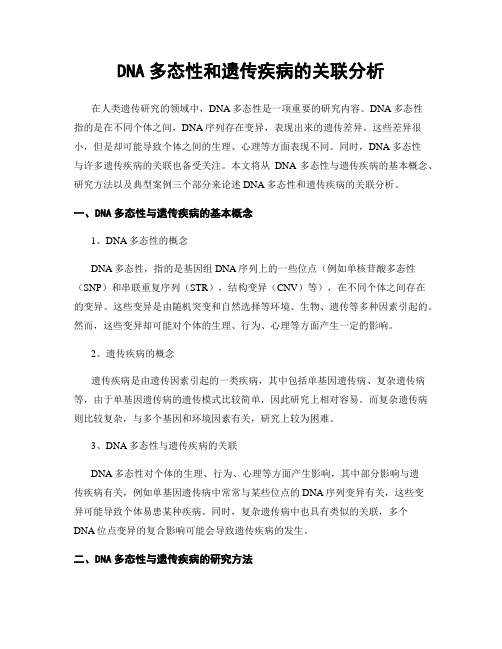
DNA多态性和遗传疾病的关联分析在人类遗传研究的领域中,DNA多态性是一项重要的研究内容。
DNA多态性指的是在不同个体之间,DNA序列存在变异,表现出来的遗传差异。
这些差异很小,但是却可能导致个体之间的生理、心理等方面表现不同。
同时,DNA多态性与许多遗传疾病的关联也备受关注。
本文将从DNA多态性与遗传疾病的基本概念、研究方法以及典型案例三个部分来论述DNA多态性和遗传疾病的关联分析。
一、DNA多态性与遗传疾病的基本概念1、DNA多态性的概念DNA多态性,指的是基因组DNA序列上的一些位点(例如单核苷酸多态性(SNP)和串联重复序列(STR),结构变异(CNV)等),在不同个体之间存在的变异。
这些变异是由随机突变和自然选择等环境、生物、遗传等多种因素引起的。
然而,这些变异却可能对个体的生理、行为、心理等方面产生一定的影响。
2、遗传疾病的概念遗传疾病是由遗传因素引起的一类疾病,其中包括单基因遗传病、复杂遗传病等,由于单基因遗传病的遗传模式比较简单,因此研究上相对容易。
而复杂遗传病则比较复杂,与多个基因和环境因素有关,研究上较为困难。
3、DNA多态性与遗传疾病的关联DNA多态性对个体的生理、行为、心理等方面产生影响,其中部分影响与遗传疾病有关,例如单基因遗传病中常常与某些位点的DNA序列变异有关,这些变异可能导致个体易患某种疾病。
同时,复杂遗传病中也具有类似的关联,多个DNA位点变异的复合影响可能会导致遗传疾病的发生。
二、DNA多态性与遗传疾病的研究方法1、多态性检测方法多态性检测方法包括PCR变性分析、基因芯片探测、测序等技术,并根据检测到的遗传变异量化来研究DNA序列的变异情况,是分析DNA多态性的重要手段。
2、遗传病研究方法遗传病研究方法包括单基因遗传病和复杂遗传病的研究方法。
单基因遗传病的研究方法包括串联分析和关联分析,复杂遗传病的研究方法则主要包括基因关联、全基因组关联研究等多种方法。
3、生物信息学方法生物信息学方法包括序列比对、成对末端序列拼接、组装等方法,通过对DNA序列数据进行分析,发现对于遗传疾病相关基因的多态性与疾病的关联,同时也需要结合动物模型,细胞实验等方法。
遗传性疾病的基因定位与鉴定

遗传性疾病的基因定位与鉴定遗传性疾病是指由基因隐性或显性突变引起的疾病,其中有些疾病是可以通过基因定位和鉴定来进行有效的治疗和预防的。
本文将介绍遗传性疾病的基因定位和鉴定的原理和方法,并分析其在临床中的应用和前景。
一、遗传性疾病的基因定位基因定位是指确定某一基因在染色体上的位置,是遗传性疾病研究的第一步。
目前,最常用的方法是遗传连锁分析和基于单核苷酸多态性(SNP)的关联分析。
1.遗传连锁分析遗传连锁分析是一种对家族成员进行基因检测的方法,用于确定某一基因是否与遗传性疾病相关联。
该方法首先需要收集家族成员的血液样本,并对样本进行基因分型和克隆分析,从而确定某一基因变异与遗传性疾病的相关性。
2.SNP关联分析SNP关联分析是通过筛选人类基因组中的大量SNP位点,分析不同基因型与疾病发生的关系。
该方法依靠单纯的遗传变异而不涉及家族关系,因此适用于广泛的人群研究。
SNP关联分析已被广泛用于多种遗传性疾病的研究,包括肿瘤、心血管疾病、神经系统疾病等。
二、遗传性疾病的基因鉴定基因鉴定是指确定某一基因的具体突变类型和位置,为遗传性疾病的诊断和治疗提供了有力的依据。
常见的基因鉴定方法包括Sanger测序、二代测序、PCR扩增、蛋白质电泳等。
1.Sanger测序Sanger测序是一种常见的基因鉴定方法,可用于对单个基因进行序列分析。
该方法基于荧光原理,通过四种不同颜色的荧光素标记四种不同的核酸碱基,从而得到DNA序列。
2.二代测序二代测序是一种高通量的测序技术,可同时对大量DNA样本进行测序,并得到高质量的DNA序列。
该技术广泛应用于基因组学、转录组学等领域,为遗传性疾病的诊断和治疗提供了强有力的支持。
3.PCR扩增PCR扩增是一种常用的基因鉴定方法,它利用DNA聚合酶在体外扩增DNA 序列。
该方法具有扩增速度快、灵敏度高、样本要求低等优点,被广泛用于DNA 检测和基因鉴定。
4.蛋白质电泳蛋白质电泳是一种检测蛋白质分子结构和功能的方法,常用于遗传性疾病的诊断和治疗。
遗传学--基因诊断与治疗

基因诊断——基因-定位-突变检测
遗传病研究范例------先天性长QT综合征(long QT syndrome, LQTS)
▪ 病因: 心肌细胞膜离子通道功能障碍 ▪ 临床表现
QT间期延长 ST-T易变 室性心动过速(ventricular tachycardia, VT) 尖端扭转性室性心动过速(Torsade de points, TdP) 发作性晕厥 心脏性猝死(sudden cardiac death, SCD)
基因诊断——基因-定位-突变检测
I
II
1
2
3
4
5
6
7
8
III
1
2
3
4
5
6
7
8
9
10
11
12
13
14
15
16
17
18
19
20
IV
1
2
3
4
5
6
7
8
9
10
11
小英家的系谱图(II-6于家系调查后猝死。)
小英的心电图:T波呈现闭表浅双峰,第二峰位于T波的顶部
基因诊断——基因-定位-突变检测
小英母亲的心电图: ECG多导联可见明显
基因诊断——遗传学原理
November小组在 研究中得到的遗传地 图,根据1387个样本 的基因组信息确定出 他们在图中的坐标位 置。不同字母缩写代 表研究对象自称的出 生国家。从中可以看 出,遗传地图与地理 地图的相似度。
基因诊断——遗传学原理
基因诊断——遗传学原理
罗刹女与猕猴
猴图腾:传说羌族巫 师因神猴引路才学得 法术。故巫师以猴皮 为帽,崇拜猴头,并 尊称猴为老祖宗、老 师傅。
基因多态位点
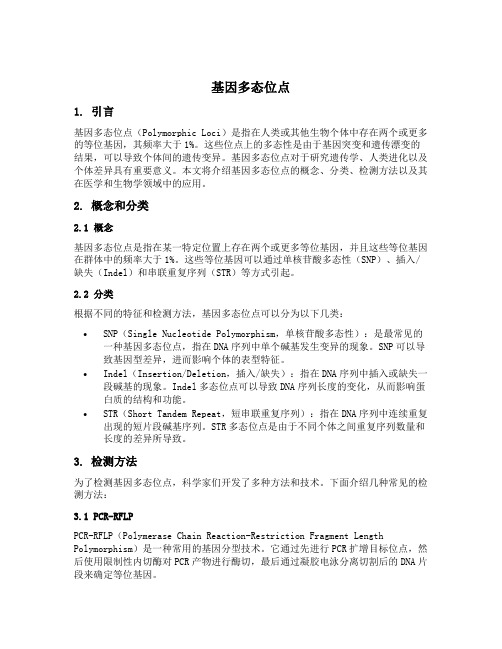
基因多态位点1. 引言基因多态位点(Polymorphic Loci)是指在人类或其他生物个体中存在两个或更多的等位基因,其频率大于1%。
这些位点上的多态性是由于基因突变和遗传漂变的结果,可以导致个体间的遗传变异。
基因多态位点对于研究遗传学、人类进化以及个体差异具有重要意义。
本文将介绍基因多态位点的概念、分类、检测方法以及其在医学和生物学领域中的应用。
2. 概念和分类2.1 概念基因多态位点是指在某一特定位置上存在两个或更多等位基因,并且这些等位基因在群体中的频率大于1%。
这些等位基因可以通过单核苷酸多态性(SNP)、插入/缺失(Indel)和串联重复序列(STR)等方式引起。
2.2 分类根据不同的特征和检测方法,基因多态位点可以分为以下几类:•SNP(Single Nucleotide Polymorphism,单核苷酸多态性):是最常见的一种基因多态位点,指在DNA序列中单个碱基发生变异的现象。
SNP可以导致基因型差异,进而影响个体的表型特征。
•Indel(Insertion/Deletion,插入/缺失):指在DNA序列中插入或缺失一段碱基的现象。
Indel多态位点可以导致DNA序列长度的变化,从而影响蛋白质的结构和功能。
•STR(Short Tandem Repeat,短串联重复序列):指在DNA序列中连续重复出现的短片段碱基序列。
STR多态位点是由于不同个体之间重复序列数量和长度的差异所导致。
3. 检测方法为了检测基因多态位点,科学家们开发了多种方法和技术。
下面介绍几种常见的检测方法:3.1 PCR-RFLPPCR-RFLP(Polymerase Chain Reaction-Restriction Fragment Length Polymorphism)是一种常用的基因分型技术。
它通过先进行PCR扩增目标位点,然后使用限制性内切酶对PCR产物进行酶切,最后通过凝胶电泳分离切割后的DNA片段来确定等位基因。
- 1、下载文档前请自行甄别文档内容的完整性,平台不提供额外的编辑、内容补充、找答案等附加服务。
- 2、"仅部分预览"的文档,不可在线预览部分如存在完整性等问题,可反馈申请退款(可完整预览的文档不适用该条件!)。
- 3、如文档侵犯您的权益,请联系客服反馈,我们会尽快为您处理(人工客服工作时间:9:00-18:30)。
• Genotype: The combination of alleles that an individual possesses. • Phenotype: The physical characteristics of a cell or organism as defined by its genetic constitution.
Resistant Genotype
Sensitive
Genotype
Background Risk Level (low)
Environmental ‘insult’ e.g., increased calories in diet
Resistant Genotype Sensitive Genotype
异表达的基因
等位基因/ 基因座/ 基因型/ 表型
• Allele: One of the different forms of a gene pair. At each autosomal locus an individual possessed two alleles, one inherited from mum and one from dad. • Locus: Unique chromosomal location defining the
Types of Mutations
Silent mutation Missense mutation
Non-sense mutation
Frameshift mutation
Chromosomal mutations
• Deletion
• Duplication • Inversion
• Translocation
SNP distribution is not uniform
• 1/3 in coding, 2/3 in non-coding.
- Types of coding region SNPs: + Synonymous: the substitution causes no amino acid change to the protein. + Non-Synonymous: the substitution results in an alteration of the encoded protein.
frame-shift mutations: a class of insertion/deletion mutations which occur within an ORF and “change the frame” of codon usage.
others: mutations in regulatory or splicing regions, chromosomal rearrangements, etc.
• Genetic variability--Differences in genetic makeup of individuals due to mutations and polymorphisms.
• Variability ensures some members survive in different environmental conditions.
Phenotypic variation is vital to species survival
• A striking feature of natural populations is a large amount of variability between individuals. This applies to all organisms including humans. • Phenotypic variability--Differences in observable characteristics (e.g., weight, height, eye color, disease state) caused by interactions of genetic and environmental factors.
Polymorphisms
• ‘Mutations’ that are propagated and maintained in the population at relatively high frequencies are called polymorphisms. • Polymorphism is defined as the existence of two or more alleles, where the rare allele appears with a frequency greater than 1% in the population. • Most mutations are quickly lost from population due to deleterious effects (natural selection) or genetic drift (random fluctuations). • Mutations may become polymorphisms due to selective advantage (heterozygotes for hemoglobin sickle cell mutation are more resistant to malaria) or genetic drift (founder effect, small group of individuals found a new population).
– One gene/protein/reaction at a time. – Test/validate isolated models at bench.
• New ‘systems biology’ approach:
– All DNA, RNA, or proteins surveyed at once. – Test/validate models experimentally and computationally. – Made possible by invention of high-throughput approaches such as the microarray technology. – Has had profound effects on biology & medicine.
The ‘-omics’ vocabulary
genome
genomics
transcriptome
proteome metabolome
proteomics metabolomics
physiome
physiomics
Mutations
- A mutation is a change in DNA sequence due to errors in DNA replication or repair. - Mutations may or may not result in an expressed phenotype. - Mutations that have no phenotype are called neutral mutations. - Mutations can alter RNA expression, processing and/or stability. - Mutations can also affect protein expression, processing, stability.
Single Nucleotide Polymorphism (SNP)
• A SNP is a source variance in a genome. A SNP is a single base mutation in DNA. • SNPs are the most simple form and most common source of genetic polymorphism in the human genome (90% of all human DNA polymorphisms). • There are two types of nucleotisulting in SNPs: – Transition(转换): substitution between purines (A, G) or between pyrimidines (C, T). Constitute two thirds of all SNPs. – Transversion(颠换): substitution between a purine and a pyrimidine.
Gene Mutation, Polymorphism, Gene mapping and identification
General organization of human genome
20000 25000
持家基因/ 奢侈基因
• Housekeeping gene : Genes which express proteins common to all cells, e.g. ribosomal, chromosomal and cytoskeletal proteins. (βactin)几乎在一切体细胞中均能被表达的基因 • Luxury gene: are those coding for specialized functions synthesized (usually) in large amounts in particular cell types.特
